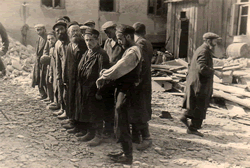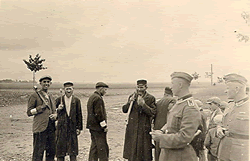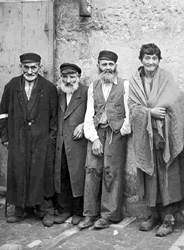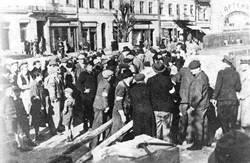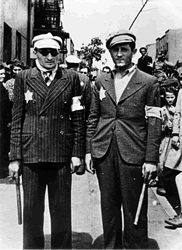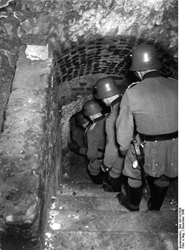|
#lbln_g-1:
|
#lbln_g-2:
|
|
#lbln_g-3: |
#lbln_g-4: |
|
#lbln_g-5:
|
#lbln_g-6:
|
|
#lbln_g-7: |
#lbln_g-8: |
#lbln_g-9: |
#lbln_g-10: Showers (left) and gas chambers (right) at Majdanek |
#lbln_g-11: Main extermination ghettos in occupied Poland marked with stars; death camps, with white on black skulls. Lublin, lower centre |
#lbln_g-12: |
#lbln_g-13: |
#lbln_g-14: |
#lbln_g-15: |
#lbln_g-16: |
#lbln_g-17: |
#lbln_g-18: |
#lbln_g-19: |
#lbln_g-20: |
#lbln_g-21: |
#lbln_g-22: |
#lbln_g-23: |
#lbln_g-24: |
#lbln_g-25: |
#lbln_g-26: |
#lbln_g-27: |
#lbln_g-28: |
#lbln_g-29: |
#lbln_g-30: |
Already in 1940, before the actual ghetto was pronounced, the SS and Police Leader Odilo Globocnik (the SS district-commander who also run the Jewish reservation), began to relocate the Lublin Jews further away from his staff headquarters at Spokojna Street,[5] and into a new city zone set up for this purpose. Meanwhile, the first 10,000 Jews had been expelled from Lublin to the rural surroundings of the town beginning in early March.[6]
The Ghetto, referred to as the Jewish quarter (or Wohngebiet der Juden), was opened on March 24, 1941. The expulsion and ghettoization of the Jews was decided in early March when the Wehrmacht troops preparing for the invasion of the Soviet Union, needed housing close to the Nazi-Soviet demarcation line.[6] The Ghetto, the only one in the new Lublin district of Generalgouvernement in 1941, was located around the area of Podzamcze, from the Grodzka Gate (renamed "Jewish Gate" to mark the boundary between the Jewish and non-Jewish sections of the city) than along Lubartowska and Unicka streets, to the boundary of the Franciszka?ska Street. Selected members of the prewar political parties such as the Jewish Bund were imprisoned in the Lublin Castle and continued to carry out their underground activities from there.[7] Widely feared collaborator was Szama (Shlomo) Grajer, owner of a Jewish restaurant with a brothel on Kowalska Street.[8] Grajer was a Gestapo informer. Dressed like a German official, Grajer summoned to his restaurant a number of wealthy Jews and extracted a ransom of 20,000 zloty from every one of them.[8] He also used to hunt for good looking girls starving in the Ghetto for his Nazi brothel, therefore the tight-knit families made sure to hide them from him.[8] Grajer had cornered the beautiful daughter of Judenrat president Marek Alten, and married her. They were shot dead together, during the final liquidation of Majdan.[8]
Liquidation of the Ghetto
At the time of its founding, the ghetto imprisoned 34,000 Polish Jews,[1] and an unknown number of Roma people. Virtually all of them were dead by the war's end. Most of the victims, about 30,000 were deported to the Belzec extermination camp (some of them through the Piaski ghetto) between March 17 and April 11, 1942 by the Reserve Police Battalion 101 from Orpo helped by Schutzpolizei.[9] The Germans set a daily quota of 1,400 inmates to be deported to their deaths. The other 4,000 people were first moved to the Majdan Tatarski ghetto – a small ghetto established in the suburb of Lublin – and then either killed there during roundups or sent to the nearby KL Lublin/Majdanek concentration camp.[1]

